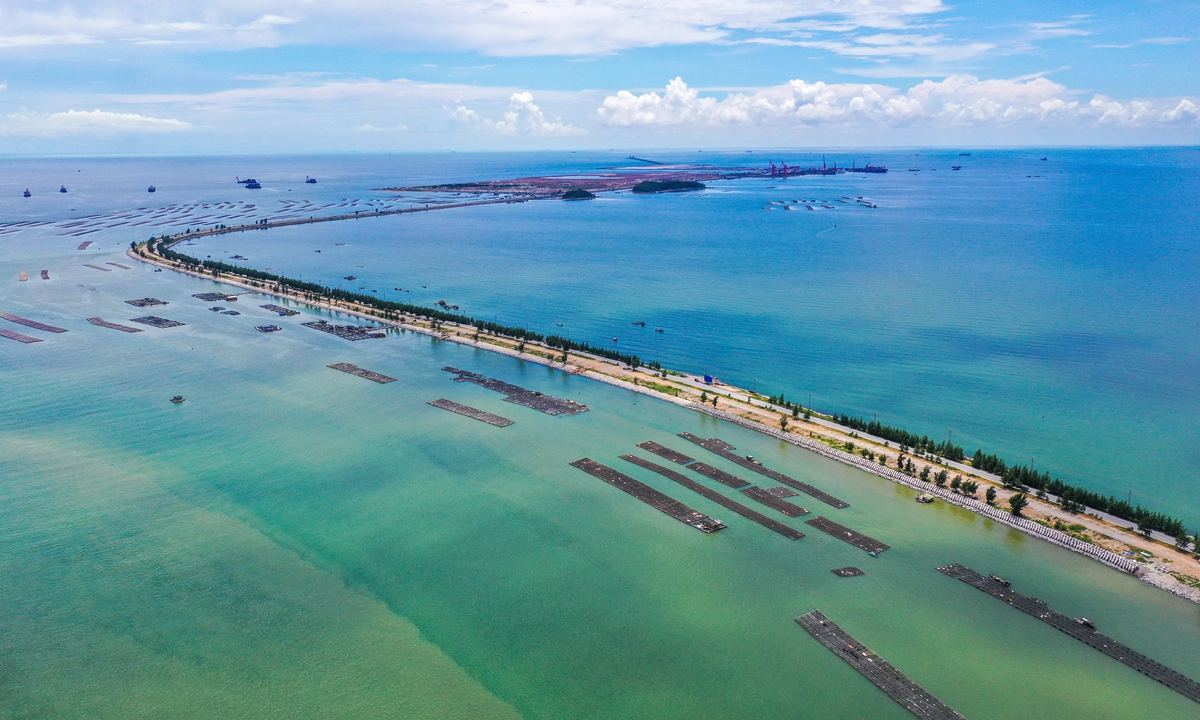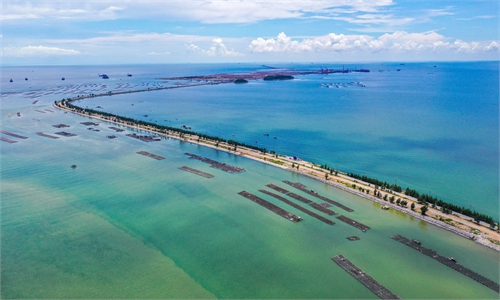China's latest delineation of territorial sea baseline in Beibu Gulf marks significant step in clarifying boundaries: expert

An overview of the Beibu Gulf in South China. Photo: CFP
China announced the baseline of the northern part of the Beibu Gulf in South China, marking another key step in the delineation of its territorial sea baseline, experts said.
The Chinese government issued a statement on Friday, regarding the baseline of the northern part of the Beibu Gulf in accordance with the Law on the Territorial Sea and Contiguous Zone promulgated in 1992.
This delineation of the baseline of the northern part of the Beibu Gulf represents the second step in the three-step process of delineating China's territorial sea baseline, completing the delineation of all baselines located in the southern part of China, which is of great significance, according to Fu Kuncheng, a special research fellow from the Belt and Road Research Institute of Xiamen University, as quoted by Shenzhen TV.
Previously, the Chinese government had twice announced the geographical coordinates of some of its territorial sea baselines and points.
The first announcement was made in 1996, when the Chinese government declared the baseline of the inland territorial sea and the names and geographical coordinates of 77 territorial sea points in the Xisha Islands.
The second announcement was made in 2012, when China declared the baseline of the Diaoyu Islands and their affiliated islands, along with the names and geographical coordinates of 17 territorial sea points.
After this third delineation, the only part of China's territorial sea baselines that has not been fully disclosed is the one alongside the Liaodong Peninsula in the Bohai Sea, observers pointed out.
The territorial sea baseline is the starting line for coastal countries to establish maritime jurisdiction claims, and also represents the outer limit of the national land territory boundary.
According to the United Nations Convention on the Law of the Sea, coastal states can have a territorial sea width of 12 nautical miles (22.22 km), a 200-nautical mile exclusive economic zone, and a continental shelf of up to 350 nautical miles.
However, due to the Beibu Gulf, a semi-enclosed bay surrounded by the inland of China and Vietnam and Hainan Island of China, having a maximum width of no more than 180 nautical miles, according to the United Nations Convention on the Law of the Sea, the exclusive economic zones and continental shelves of the two countries in the Gulf overlap entirely, making the entire Gulf an overlapping area of Chinese and Vietnamese claims, which must be resolved through delimitation.
Prior to the 1960s, China and Vietnam only exercised jurisdiction based on the width of the territorial sea declared by each other, sharing resources within the bay, with no major issues arising.
In the early 1970s, with the development of modern maritime legal systems, the issue of delimiting the territorial sea, exclusive economic zone, and continental shelf in the gulf between China and Vietnam emerged, reported by Shenzhen TV.
On June 30, 2004, representatives of China and Vietnam signed an agreement on the delimitation of the territorial sea, exclusive economic zone, and continental shelf in the Beibu Gulf, achieving a fair delimitation result satisfactory to both parties. The signing of this agreement marked the establishment of the first maritime boundary of China.
However, the delimitation agreement in 2004 did not fundamentally eliminate the maritime disputes between China and Vietnam in the relevant waters, as the boundary facing the sea was still unclear, Fu said.
Fu said that only with the determination of the baselines can law enforcement officers clearly measure and calculate the outer boundary of the 12-nautical mile territorial sea from the straight baseline.
"Although there has always been a 12-nautical mile territorial sea, it was never precise. If someone was right on the edge of that 12-nautical mile, there was no clear boundary, making it difficult to comply. It would also be difficult for China to enforce the law," he explained. "By determining these baselines, we can further clarify the outer boundary of our territorial sea in the Beibu Gulf on the nautical chart, and the outer boundary of the 200-nautical mile will also be very clear."
Global Times



